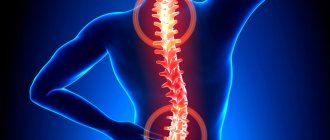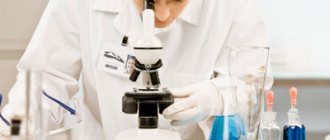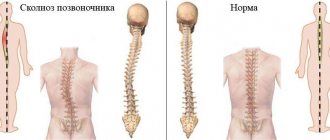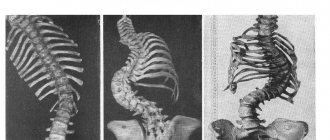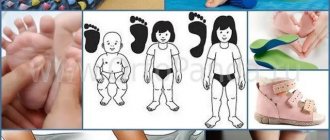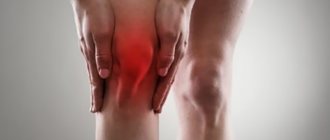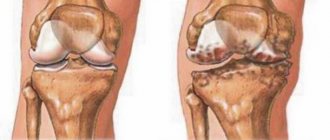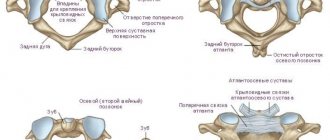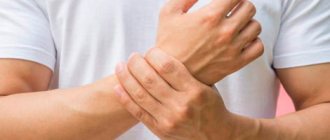The word “scoliosis” literally means “crooked” in Greek. This characterizes this disease quite accurately. Experts note that scoliosis is a curvature of the spinal column. The pathology is easily diagnosed during an x-ray. In the image, a specialist can see the angle of deviation of the ridge from the axis along the frontal plane.
Persistent changes in the spinal column are formed under the influence of genetic and external factors. Depending on the location of the pathological process, scoliosis can be cervical, thoracic, lumbar, or combined. The disease can appear at any age, but most often it is diagnosed in schoolchildren aged 6-7 years. In this article we will talk in detail about stage 1 scoliosis.
What is scoliosis?
The name of the disease comes from Greek and means “crooked”.
In simple terms, scoliosis is a lateral curvature of the spine. Most often, scoliosis appears in children who have just started school. Constantly sitting at a desk in the wrong position leads to the fact that the fragile children's spine begins to deform. Curvature occurs and, accordingly, the child can be diagnosed with grade 1 scoliosis. There are 4 degrees of scoliosis:
| Degree | Description | Degree of spinal deformity |
| 1st degree scoliosis | In the first degree, the curvature of the spine is not very pronounced. Most often it is even difficult to notice with the naked eye. The diagnosis is made only after X-ray diagnostics. | The deformation angle varies from 1 to 10 degrees. |
| 2nd degree scoliosis | At this stage of development of the disease, the deformation can be seen with the naked eye. Characteristic is the appearance of muscle asymmetry in the area of the most protruding part of the spine. | The deformation angle varies from 11 to 25 degrees. |
| 3rd degree scoliosis | The third degree is characterized by a strong noticeable curvature with a pronounced deformation of the chest. A rib hump appears. | The deformation angle varies from 26 to 50 degrees. |
| 4th degree scoliosis | Severe deformation extends to the chest and abdominal areas, and the back area. Disturbances in the functioning of internal organs, in particular the stomach and lungs, are detected. | The deformation angle is 50 degrees or more. |
Classification of scoliosis
Depending on which direction the spinal deformity is directed, right-sided and left-sided scoliosis .
From the point of view of the shape of the curvature, scoliosis is divided into S -shaped (the line of the spine is bent in two places), C-shaped (the line of the spine is bent in only 1 zone), Z -shaped (the line of the spine is bent in three areas).
According to the shape of the bend, scoliosis is divided into three types
Depending on the origin, scoliosis is divided into:
- Congenital (hereditary) . Appears due to the characteristics of intrauterine development of the fetus. Most often it can be an “inheritance” from one of the parents;
- Idiopathic. One of the most common types of disease. Despite its widespread prevalence, clear causes for the occurrence of this type of scoliosis have not yet been identified. According to general data, it is believed that idiopathic scoliosis occurs due to rickets or diseases of the neuromuscular system;
- Neurogenic. Develops due to diseases of the nervous system (polio, paralysis, etc.);
- Static. Appears when there are disturbances in the growth of the musculoskeletal system, due to the peculiarities of the development of joints.
Prevalence and significance of scoliosis
Most often, scoliosis occurs in children and adolescents from 5 to 17 years old inclusive . The most common are grades 1 and 2 spinal deformities (aged 5 to 12 years - 12% of boys, and about 15% of girls). Between the ages of 13 and 17, the percentage of patients with grade 1-2 scoliosis increases: boys account for 28%, and girls 34% .
Statistics show that scoliosis is the most common companion for middle and high school students. Fortunately, the largest percentage of the identified disease is of the preclinical form, so everything is fixable. Scoliosis of the 1st degree remains the most common.
The significance of this disease should not be downplayed, since a mild form of scoliosis can develop into a more serious one and lead to disability.
Of course, a considerable period of time must pass for this, but with due inattention this period can be shortened. Therefore, it is worth paying attention to your spine from the very first days of diagnosing the disease and starting recovery as early as possible. Then you will avoid many complications and ailments.
Diagnostics
If such changes occur, you should contact an orthopedist or vertebrologist. The doctor will conduct a full examination of the patient, during which he pays special attention to:
- limb length and joint mobility;
- severity of kyphosis;
- symmetry of the position of the shoulder blades, waist triangles, and shoulders;
- condition of the chest and back muscles;
- lumbar mobility and severity of lordosis;
- position of the pelvic bones;
- the nature of the location of internal organs.
The data obtained during a visual examination is sufficient to suggest the presence of scoliotic deformity. Next, the patient is prescribed X-ray examination, CT and MRI to determine the shape and degree of curvature of the spine. Thanks to these instrumental diagnostic methods, it is possible to detect vertebral rotation and accurately calculate the angle of curvature according to Cobb or Chaklin. As a result, the specialist receives comprehensive data about the nature of the deformation and can select the optimal treatment tactics in this case.
Risk factors for developing the disease
For those who have been diagnosed with one degree or another of scoliosis, the question will always be relevant: what can the disease lead to? Is there a high risk of developing serious complications and developing the disease to more serious degrees?
Of course, there is always a minimal chance, but don’t be scared right away. First, you need to consider the origin of your disease: congenital or acquired. The congenital type has a slightly higher chance than the acquired type. The localization of scoliosis in this case is not particularly important.
There are a number of common factors that can influence the worsening of scoliosis:
One of the reasons for the development of scoliosis is muscle weakness. The presence of deformities in one (or both) parents;- Congenital muscle weakness;
- Poor posture (including hyperlordosis);
- The presence of other deformities not associated with scoliosis (deformations in the chest or hip region);
- Presence of systemic hypermobility. This factor will apply to people involved in one or more sports that require a lot of stretching (ballet, gymnastics, yoga);
- Weak muscle activity and passive lifestyle;
Of course, this is not the entire list of factors that can aggravate the situation. We advise you to consult a specialist as soon as a diagnosis is made. The doctor will be able to give recommendations and monitor the treatment process, and will also ensure that complications do not develop.
Video: “What is scoliosis?”
What are the benefits of therapeutic exercises?
Therapeutic gymnastics is not just a sport or fitness, but a real medical discipline.
It is developed taking into account the physiological characteristics of a person and helps restore or strengthen the patient’s health and effectively recover from injuries. If you follow the rules and recommendations of physical therapy, you can:
- restore lost functions;
- increase the strength and endurance of the body;
- adapt the patient;
- improve mental functioning;
- improve the functioning of organs and vital systems of the body.
For scoliosis, therapeutic exercises are necessary to prevent further development of the disease and complications. By doing the exercises, you will maintain the health and mobility of your spine for many years.
Causes of scoliosis of the 1st degree
There are quite a few reasons for the onset of the initial stage of scoliosis. These may be hereditary causes associated with congenital disorders that were passed on from one or both parents.
In the case of idiopathic, i.e. acquired scoliosis is also not so simple. The most common reasons for the appearance of slight deformation are :
- A sedentary lifestyle, which is accompanied by incorrect posture. Most often this is typical for schoolchildren and people with a “sedentary” type of work (office workers, programmers, architects, proofreaders, etc.). On this basis, the most common is right-sided thoracic scoliosis (because it is with the right hand that we write and hold the computer mouse);
- Sports factor. Sometimes scoliosis can develop as a result of a seemingly completely healthy activity - sports. Those athletes whose load is distributed unevenly during sports training are often at risk (tennis players, archers, etc.);
- Predisposition to poor development of ligaments, muscles and nervous system. Everything here is extremely simple: muscles that are too weak cannot maintain posture in the correct position. This problem often occurs in people of the asthenic type (hypotonic people with low weight and a “thin” nervous system). Such people should take care of themselves from childhood: do physical exercises that strengthen the muscles of the back and chest, maintain posture, monitor nutrition, try to avoid excessive stress;
- Joint hypermobility . Excessive mobility and flexibility of the spine can be both a cause for the development of the first degree of scoliosis and an aggravating factor;
There is also a small list of reasons that are more rare:
- Rickets;
- Congenital vertebral deformity and torticollis;
- Metabolic disorders in bones;
- Limb injuries and amputations.
Symptoms of scoliosis 1st degree
In the early stages, scoliosis is practically invisible to the naked eye. There is also the possibility of misdiagnosis when muscle imbalance is mistakenly diagnosed as scoliosis.
There are a number of features that will help determine the presence of the first degree of vertebral deformity:
- Slight pain in the back and cervical region;
- Shoulder asymmetry;
- Asymmetrical position of the pelvis;
- Excessive stooping;
- Straightening the spine in a horizontal position.
Most often, at the first stage, left-sided scoliosis of a benign nature of the C-shaped type occurs. If you do not deal with the problem immediately, then in the future the shape will change to S-shaped (a second arc will appear for balance). But such cases are rare in the first stage .
Diagnosis of the disease
Did you know that...
Next fact
The most common age for diagnosing scoliosis of the first degree is the age from 11 to 16 years . The percentage of girls in this case is slightly higher than the percentage of boys. This fact is explained by the fact that the structure of bone tissue in girls is much more fragile, and the muscle frame is weaker than in boys.
The most common origin of first-degree scoliosis is idiopathic. Therefore, it is not possible to find out the specific reason for its appearance.
There are a number of diagnostic measures that allow timely detection of changes in the spine:
The very first and most important event. The only disadvantage is that X-rays cannot be taken more than once every few months due to the high level of radiation;
First-degree scoliosis is diagnosed mainly using an X-ray.- Photographic photograph. This photograph is taken against the backdrop of a checkered wall. The doctor takes several photographs from different angles: full-length from the front, from the side, in the normal position of the body;
- Optical topography . This method is carried out using refracted fixed light. This beam allows you to see the curve of the back. The results are photographed and processed on a computer using specialized software;
- Scoliometa. Such diagnostics are carried out using a specialized device that helps determine the degree of curvature in a numerical value.
Treatment of scoliosis 1st degree
The first degree of scoliosis is the most harmless at its stage. Therefore, with timely correct diagnosis, correcting deformed vertebrae will not be as difficult as in later stages.
Drug treatment
Most often, serious medications are not used at this stage. The doctor prescribes vitamins and restoratives. The most common medications to support the body during the treatment of first-degree scoliosis are :
- Multivitamins (Multi-Tabs, Pikovit, Alphabet);
- Strengthening preparations (tinctures of Eleutherococcus and ginseng);
- Chondroprotectors (prescribed for older patients who need to maintain the integrity and functionality of cartilage tissue).
Surgical method
This degree of scoliosis does not require surgical intervention. Therefore, you should not think about surgery .
Massage and physical therapy
The most effective methods of combating first-degree scoliosis are therapeutic massage and physical exercise.
The main goal of massage for this problem is to prevent muscle hypertonicity, as well as the formation of a muscle roll, and restore proper blood flow and metabolism.
Effective massage techniques today remain:
- Trituration;
- Vibration;
- Deep friction with weight elements;
- Deep stroking.
A massage course should consist of at least 10 sessions. Techniques should alternate; uniformity is not encouraged.
As for physical therapy, if you follow the instructions correctly, you can truly count on magical healing. It is physical exercises designed specifically for the treatment of first-degree scoliosis that remain the main method of posture correction in modern medicine.
Important! Only a doctor or instructor can prescribe the correct set of exercises. It is necessary to determine the level of curvature of the spine, as well as its type and shape. Only after this can a course of therapeutic physical exercises be prescribed, which is important to perform based on the instructions of the doctor (instructor), and not to engage in arbitrariness, so as not to harm the spine even more.
Therapeutic exercises should be performed at least 2-3 times a week, but do not overload the spine and muscles, since their weakening can lead to aggravation of the situation and even greater deformation. Monitor the dynamics, consult with your attending surgeon, repeat x-ray diagnostics.
As an example, here are a few exercises that are most often prescribed to people with scoliosis at the initial stage.:
- Warm up muscles . Get on all fours and move around the room in this position for about 5 minutes. Have fun with yourself and your household;
Lie on your back (on a flat surface). From this position, try to stretch your head and heels in opposite directions. Repeat these stretches 5 times (10 seconds each);
Stage 1 scoliosis is treated with the help of physical therapy: Spinal stretching.- Strengthening the muscles of the anterior abdominal wall. Lie on your back and raise your legs straight. While in the air, make a scissoring motion with your feet. The exercise should be done 10 times, after a 3-minute break. Each session, try to keep your feet as close to the floor as possible to strengthen your abs more effectively;
- Strengthening your back muscles . Lie on your stomach and elevate your legs and arms. Try to make movements as if you were swimming breaststroke. Do 3 series of such movements 8-10 times;
- Another exercise to strengthen your back. Lie on your stomach and do the scissors exercise. Move your legs both vertically and horizontally. Repeat a series of 8-10 movements after a short break;
- General strengthening exercise . Stand straight, bend your elbows. Grab your shoulders with your fingers. Perform circular movements with your elbows, 10-15 turns twice. Do the exercise at low speed.
What not to do?
Those who have been diagnosed with scoliosis should avoid prolonged fixed body positions. The position should be changed every twenty minutes, especially if you feel discomfort.
Avoid carrying bags and packages in one hand. It is better to give preference to a backpack, or try to evenly distribute the load into two bags so that you can carry them in both hands.
When engaging in physical education and sports, the following are prohibited:
- Power training. Contribute to increased stress on the spine.
- Acrobatics. Most of the exercises are sharp and asymmetrical.
- Jumping, running, somersaults.
- Football basketball. There is a lot of jumping going on during games. This negatively affects the condition of the intervertebral discs. There is a high risk of injury.
For scoliosis of the 1st degree, tennis is allowed. But in the second stage you can only play table tennis.
Prevention and diet for scoliosis of the 1st degree
The best prevention is to follow the order “Straighten your back!” Oddly enough, but during a developed habit of monitoring posture can prevent the development of scoliosis. In addition, try to do general strengthening physical education and keep your muscles toned.
The diet should be balanced, rich in vitamins and minerals . Try to forget about alcohol (this is especially true for people with nervous disorders). Avoid spicy, fatty and too salty foods. Also try to be more careful with sweets. If you notice symptoms of emerging deformation, consult a doctor as soon as possible and get diagnosed.
